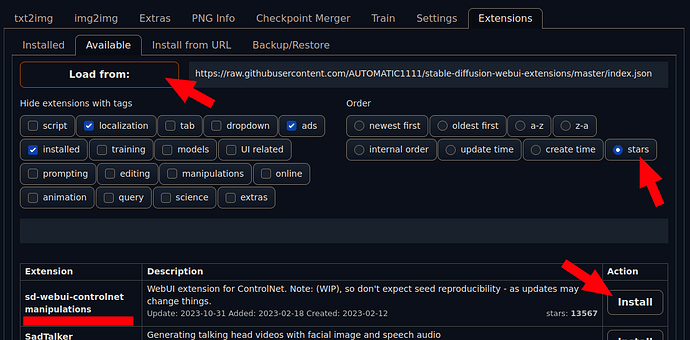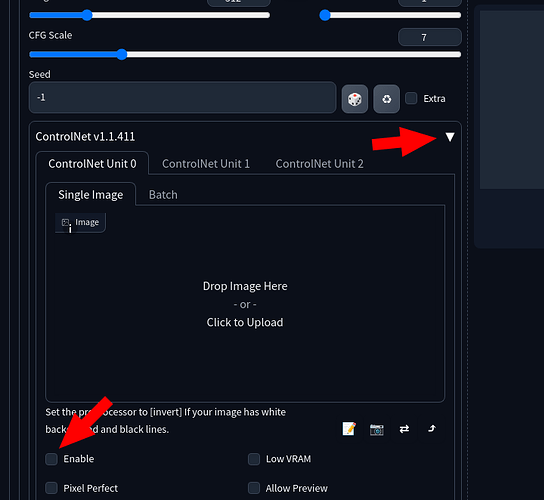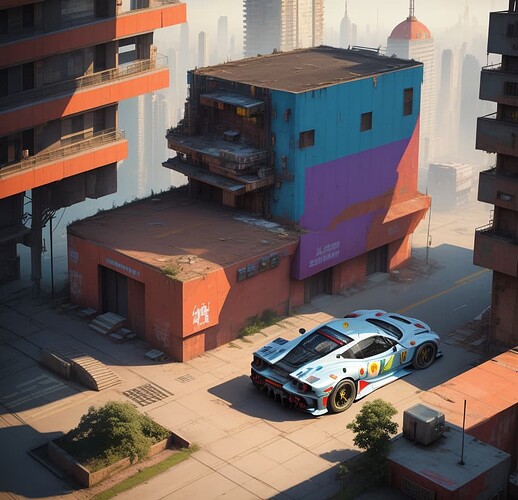Self-hosting advanced AI text-to-art
As of writing Stable Diffusion combined with AUTOMATIC1111’s stable-diffusion-webui provides the most advanced AI text-to-art experience that can be self-hosted and many of it’s features don’t exist on any other free or proprietary platforms.
Note: Make sure to install ControlNet below to double the value of stable-diffusion.
Why does this guide use conda?
conda allows you to run python apps with separate python and library versions without conflicts with the OS.
Hardware
This section is a summary limited to my research and experience and shouldn’t be considered the final word.
Recommended: Nvidia GPU with 6GB of VRAM or higher. >=8GB VRAM recommended.
AMD and Intel
While you can run sdw (stable-diffusion-webui) on AMD GPUs, Intel GPUs and Intel CPUs i’ve never done so. AMD GPUs may also need double the VRAM to perform the same actions (citation needed). See the sdw git docs for details.
Nvidia
Ampere series (latest) GPUs are the most recommended for both cost and features but Turing, Volta, Pascal and Maxwell series GPUs should all work. See: cuda support
I recommend the following cards and have used both with stable-diffusion-webui
Cheapest card: Nvidia Quadro P4000 8GB
Best AI all-rounder and value for money (by far): Nvidia RTX 3060 12GB
Resources:
https://en.wikipedia.org/wiki/List_of_Nvidia_graphics_processing_units
https://en.wikipedia.org/wiki/CUDA
Installing drivers
Blacklisting nouveau
# Check if you have nouveau drivers installed
lsmod | grep nouveau
If this command prints anything follow this guide to blacklist nouveau.
Installing drivers
# Check if your card is recognized
lspci | grep VGA
If Linux isn’t pickup up the card make sure the hardware is physically installed correctly with enough power and is operational.
# Check if your card is using nvidia drivers
lsmod | grep nvidia
If there’s no output, follow this install guide for ubuntu or run this for Debian: sudo apt install nvidia-driver
Install cuda and test
sudo apt install nvidia-cuda-toolkit
# Confirm your card is visible
nvidia-smi
# Confirm cuda drivers are installed
nvcc --version
# Reboot
reboot
Install stable-diffusion-webui in a conda environment
Install dependencies
sudo apt update
# Packages used in this guide
sudo apt install wget curl
# Packages used by stable-diffusion-webui
sudo apt install git libgl1 libglib2.0-0 -y
# Optional packages
# (Resolves error: Cannot locate TCMalloc (improves CPU memory usage))
sudo apt install libgoogle-perftools4 libtcmalloc-minimal4 -y
Install miniconda
curl -sL "https://repo.anaconda.com/miniconda/Miniconda3-latest-Linux-x86_64.sh" > "Miniconda3.sh"
bash ./Miniconda3.sh
# Press Enter to continue
# Press q to quit license
# Type yes to accept license
# Press Enter to confirm install location
# Type no to not have conda auto-initialize on opening a shell
Create a conda environment for stable-diffusion-webui running python 3.10 and activate it
source ~/miniconda3/etc/profile.d/conda.sh
conda create -n sd-webui python=3.10 -y
conda activate sd-webui
Install stable-diffusion-webui
wget -q https://raw.githubusercontent.com/AUTOMATIC1111/stable-diffusion-webui/master/webui.sh
bash ./webui.sh
Wait for downloads to finish, this will take a long time and requires stable internet.
Resolving webui.sh errors (skip if there’s none)
# Cloning Taming Transformers
# For error: "error: RPC failed; curl 56 GnuTLS recv error (-54): Error in the pull function."
cd ~/stable-diffusion-webui/
git config --global http.postBuffer 1048576000
cd ~
# If internet is unstable, loop installation till it completes
while ! bash ~/webui.sh; do sleep 10; done
Test
In another terminal, test if the site is up. You should see pages of HTML.
curl http://127.0.0.1:7860
Exit the active stable-diffusion-webui instance using Ctrl+C
How to launch stable-diffusion-webui in future
The conda environment needs to be activated, then webui.sh can be run.
OPTION 1: Run these commands each time
source "$HOME/miniconda3/etc/profile.d/conda.sh"
conda activate sd-webui
bash "$HOME/webui.sh" -f --port 7860 --xformers
OPTION 2: Make a launch function in your .bashrc
# Paste this block into terminal and press enter
cat <<-'SDLauncher' >> ~/.bashrc
sd-webui() {
source "$HOME/miniconda3/etc/profile.d/conda.sh"
conda activate sd-webui
bash "$HOME/webui.sh" -f --port 7860 --xformers
}
SDLauncher
Close and re-open your terminal, now all you need to run is:
sd-webui
Optional installation of models and enhancers (highly recommended)
# Models
cd $HOME/stable-diffusion-webui/models/Stable-diffusion
wget -c https://huggingface.co/ckpt/rev-animated/resolve/main/revAnimated_v11.safetensors
wget -c https://huggingface.co/runwayml/stable-diffusion-v1-5/resolve/main/v1-5-pruned-emaonly.safetensors
# VAE
cd $HOME/stable-diffusion-webui/models/VAE
wget -c https://huggingface.co/stabilityai/sd-vae-ft-mse-original/resolve/main/vae-ft-mse-840000-ema-pruned.ckpt
# Pre-download upscaler models
cd $HOME/stable-diffusion-webui/models/ESRGAN/
wget -c https://github.com/cszn/KAIR/releases/download/v1.0/ESRGAN.pth
cd $HOME/stable-diffusion-webui/models/RealESRGAN/
https://github.com/xinntao/Real-ESRGAN/releases/download/v0.1.0/RealESRGAN_x4plus.pth
wget -c https://github.com/xinntao/Real-ESRGAN/releases/download/v0.2.2.4/RealESRGAN_x4plus_anime_6B.pth
# Embeds for prompt enhancement
cd $HOME/stable-diffusion-webui/embeddings
wget -c https://huggingface.co/yesyeahvh/bad-hands-5/resolve/main/bad-hands-5.pt
wget -c https://huggingface.co/datasets/Nerfgun3/bad_prompt/resolve/main/bad_prompt_version2.pt
wget -c https://huggingface.co/Xynon/models/resolve/main/experimentals/TI/bad-image-v2-39000.pt
wget -c https://huggingface.co/datasets/gsdf/EasyNegative/resolve/main/EasyNegative.pt
Optional: GUI Configuration
Open a browser and go to: http://127.0.0.1:7860
Enable a VAE (if you installed it above):
- On the top bar, click “Settings”
- On the side bar, click “Stable Diffusion”
- Click the “SD VAE” dropdown and choose: vae-ft-mse-840000-ema-pruned.ckpt
- Click “Apply settings”
Install ControlNet (and other extensions):
In the txt2img and img2img sections you’ll now have ControlNet
Privacy/Security note
The web interface uses CSS from fonts.googleapis.com and a script from cdnjs.cloudflare.com. These online dependencies can be removed by downloading and localizing the references. I’ll write a script to do this automatically if there’s demand.
Using Stable Diffusion
Renders are stored in: ~/stable-diffusion-webui/outputs/
Example Prompt
AI model: revAnimated_v11.safetensors
Sampling: Euler a
CFG Scale: 6
Pixel range: 1080x720
Positive Prompt
((best quality)), ((masterpiece)), ((realistic)), (detailed), (cyberpunk), (Ferrari), race cars, blender, intricate background, intricate buildings, ((masterpiece)), HDR
Negative prompt
(semi-realistic:1.4), (worst quality, low quality:1.3), (depth of field, blurry:1.2), (greyscale, monochrome:1.1), nose, cropped, lowres, text, jpeg artifacts, signature, watermark, username, blurry, artist name, trademark, watermark, title, multiple view, Reference sheet







